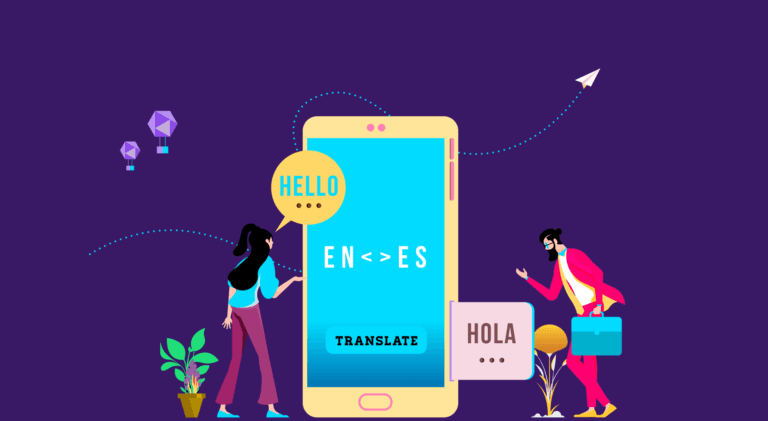
We all know that the internet has taken the world by storm. It is now easier for businesses to expand locally. So when you want to launch into a new market with local content, is Google Translate all you will need for localizing content? After all, it’s simple: just upload your digital content and have it translated within seconds. However, it’s easier said than done.
Online translation tools might help with low-value content, but if you want to create an impact, localizing content is the way to go. You must consider culture, traditions, language, and customer preferences while going local. You can’t simply have a no-context conversation while breaking into a new market, can you?
What is Content Localization?

Producing quality content tailored to a specific market is known as content localization. It goes far beyond merely translating words into another language. Today, customers expect companies to know their local language and respect their cultures and traditions. Showing sensitivity towards natives plays an essential role in creating a positive brand image.
So, what is the need for localizing content? Here are a few reasons:
● Localized content holds the power to give your company a competitive edge while creating brand awareness.
● According to a study by the Common Sense Advisory, 65% of people prefer content in their local language.
● The same study also said that 73% of people prefer to read reviews in their native language.
10 Content Localization Best Practices
Now that you know why it’s essential to localize content, let’s dive into a few tips for localizing content with ease.
1. Research your market
Right at the beginning, you need to gather information about the market you wish to expand in. The timing and tone of your content can make a big difference.
For example, you cannot launch a promotional campaign on a day that is considered tragic or inauspicious in a certain country. Also, content that works in India might not be apt for Kenya due to a vast cultural difference. Things as simple as word choice or grammar can result in a faux pas. You can easily avoid this when localizing content if your research is in place.
2. Start by localizing images.
When your business is kicking off in a new market, you must consider cultural and religious aspects. Remember that you need colors and visuals that people will connect to while keeping your brand essence in place. As a digital marketer, you must take the time to understand the intricate differences between each market to create maximum impact while localizing content.
Dos
● Use natural images relevant to the local market.
● Abstract images, illustrations, and geometric shapes are a safe bet.
● Use globally recognized symbols for a better connection with the target audience.
Don’ts
● Use hand or body gestures that could mean something else
● Insert religious symbols with different meanings
● Emotionally charged images or immodest dressing
For example, Nescafé has created different layouts and images for its global market. See the difference in the images used for a website in The Netherlands vs. one used in Indonesia.


3. Consult with someone local
It is, of course, not good enough to leave your translation needs to an AI tool. Instead, consult with someone who is part of your target market. Such people are familiar with the daily happenings of the city or country. They might give better advice than someone who has visited the country briefly. Local translators are the right people to point out loopholes in your digital marketing strategy.
Similarly, you can also appoint a professional translation service for a seamless process.
4. Offer personalized experiences
In a research conducted by CMO by Adobe, 42% of people feel disappointed when content isn’t personalized. Is this how you want to enter a new market? Definitely not! Localizing content is the epicenter of creating a personalized experience.
Tailoring your product or service to match the target audience’s needs is a great way to foster relationships. Coca-Cola is an example of a brand that went to great lengths to offer localized content.

5. Start small
Localizing content can take an extensive amount of time and resources. To minimize risk while starting afresh in a new market, you must start small. Consider the following.
● Rather than using content localization services for everything in one go, start with a small campaign.
● Build demand with a paid digital campaign to get more hits on your landing page or social media post.
● Utilize all marketing channels for maximum impact.
6. Build technical know-how
Going beyond cultural differences, you must be aware of the difference in the use of technology in different countries. For example, Indians mostly use their phones for everything: WhatsApp, social media tools (Instagram, Twitter, or Facebook), and even website browsing. On the other hand, Americans mostly use desktops or iPads for accessing websites. This is what makes web content localization equally significant.
So when you’re creating content for a digital marketing campaign, ask yourself these questions:
● Will my target audience be able to take action on the mobile device?
● When I translate content from English to Arabic or Spanish, does the content spill into the margins of the website due to specific phrases?
7. Utilize tools smartly
Going local is never easy. Depending on how large your business is and what your digital marketing strategy aims to achieve, you might have multiple pieces of a crossword to juggle.
Use local automated translation tools for small tasks to meet your deadlines. Several content localization tools could act as a powerful tool to launch your business in a new market.

Creating localized content is more than just translating the same message into a native language. Do a quick cross-check with a local agency or translator before going live with your campaign.
8. Authenticity is the name of the deal.
Being authentic is the key to connecting with the audience. As a digital marketer, you must go beyond just using the correct phrases and words. Keep the following in mind:
● Know how the local demographic connects with your brand colors.
● Consider page elements and layout.
● Check payments and delivery methods that work for your business and the organization.
● Localize SEO elements in your content, such as URLs, meta descriptions, menu options, and image alt tags.
● Some Asian and Arab countries read and write languages from right to left.

9. Be clear and concise.
Brevity is key when it comes to localizing content. But that doesn’t mean you sacrifice clarity in your communication. To avoid ambiguity, keep the following in mind while creating content:
● Avoid slang, idioms, and references where the meaning could change when translated.
● Avoid words with multiple meanings (for example, using “because” instead of “since”).
● Provide clear context when necessary.
10. Understand the difference between regional and area-specific content
When you’re establishing your brand or business in a new market, it is essential to establish a few factors:
● Are you targeting a country or a region in a country?
● Is your market an entire continent?
These factors play a crucial role in creating localized content. For example, if a brand wishes to enter the Asian market, you must remember that Asia is a large and vast continent with varying cultures. Content that works wonders in Hong Kong or South Korea might not work in India or Sri Lanka.
The Final Word
Content is key to creating a good first impression. Customers prefer seeing communication in their native language with personalized, culturally appropriate content. So when it comes to launching your brand or product in a specific market, you need to think about localizing content from the get-go! A good localization strategy does not guarantee success, but not having one can definitely amount to failure.
Key Takeaways
● Consider localizing content as one of your first steps when entering a new market.
● Adopt localization as part of your umbrella marketing campaign: be it websites, social media, print advertising, or even outdoor advertising.
● Create personalized, niche content suitable for your target audience.
● Be mindful of hand gestures, religious symbols, political references, and immodest clothing to avoid hurting sentiments.
● Connect with a local agency or translator to create culture-specific local content.
● Utilize automated technology and tools optimally. Machines that offer automated translation cannot replace human translators.
FAQs
With globalization, every brand needs localized content in order to attain success. Content localization primarily means creating content that is specific to a certain country or region. Localizing content is important because:
● It helps enhance the value of your brand.
● It helps create a better personal relationship with the target audience.
● The brand sounds authentic and real.
● It gives the brand a competitive edge.
You can follow the below-mentioned steps to do so:
● Define a digital marketing strategy with cultural aspects in mind.
● Create a workflow and stick to it.
● Translate the web page content.
● Use international guidelines and norms, but keep local rules in mind.
● Utilize appropriate software.
Here are a few ways to improve your content localization:
● Hire a local agency or person to help you understand cultural nuances.
● Adapt your product and service offerings as per the market you want to enter.
● Create personalized and memorable experiences for your target audience.
● Leverage your brand USP while keeping your values in mind.
● Start with a small campaign and build on it gradually.
● Ensure you use imagery and words that your target audience connects with.
● Invite the community to participate in the campaign.
● Cater to local needs and expectations.
Latest Blogs
Learn how to rank on AI search engines like ChatGPT, Perplexity, and Gemini by optimizing your content for authority, structure, and relevance. Stay ahead in AI-driven search with this strategic guide.
Explore the best healthcare SEO services for your medical practice. Improve online visibility and effectively reach more patients in need of your services.
Discover top social media agencies specializing in banking solutions, enhancing financial services and driving engagement.
Get your hands on the latest news!
Similar Posts

Translation
5 mins read
All You Need to Know About Language Translation and Terminology Management

Translation
5 mins read
6 Reasons to Translate Content into German

Translation
5 mins read